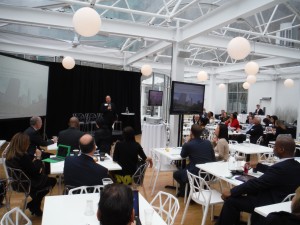 Business-Community Impact Symposium. Four words, when combined, signal an important convening. Held at Celsius, an unusual all glass house in Bryant Park, participants could ponder intriguing thoughts and glance out at ice skaters and the snowy New York surroundings. I was honored to be the program director, and master of ceremonies, for this conference put on by The Conference Board. When I was asked to lead this conference, I told them that I wanted to do something different. There are many conferences in the CSR and corporate philanthropy space. The plan was to create an intimate, collaborative space that fostered dialog between peers. The day and a half took on different forms. Ted-Talk style talks, fast paced panels and Impact Moments. Thirty-six speakers shared their wisdom and experience.
Business-Community Impact Symposium. Four words, when combined, signal an important convening. Held at Celsius, an unusual all glass house in Bryant Park, participants could ponder intriguing thoughts and glance out at ice skaters and the snowy New York surroundings. I was honored to be the program director, and master of ceremonies, for this conference put on by The Conference Board. When I was asked to lead this conference, I told them that I wanted to do something different. There are many conferences in the CSR and corporate philanthropy space. The plan was to create an intimate, collaborative space that fostered dialog between peers. The day and a half took on different forms. Ted-Talk style talks, fast paced panels and Impact Moments. Thirty-six speakers shared their wisdom and experience.
The World: Post 2015. United Nations Sustainable Development Goals. 2015 is a critical 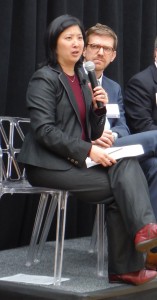 year on the world stage. The Millennium Development Goals (MDGs) end and the Sustainable Development Goals (SDGs) will be launched. Issues range from education, climate change, and gender equality to poverty alleviation. Unlike the MDGs targeted to developing countries, the SDGs are just as relevant in Detroit as they are in Mumbai. The conference began with this important topic and was moderated by Jennifer Kim Field, VP of Global Partnerships, UN Foundation. A blog, Sustainable Development Goals through the Lens of Corporate Philanthropy, goes into detail of some of what was discussed. http://tcbblogs.org/philanthropy/2015/01/08/sustainable-development-goals-through-the-lens-of-corporate-philanthropy/#sthash.W0fPK2Ek.B7NUT5yG.dpbs
year on the world stage. The Millennium Development Goals (MDGs) end and the Sustainable Development Goals (SDGs) will be launched. Issues range from education, climate change, and gender equality to poverty alleviation. Unlike the MDGs targeted to developing countries, the SDGs are just as relevant in Detroit as they are in Mumbai. The conference began with this important topic and was moderated by Jennifer Kim Field, VP of Global Partnerships, UN Foundation. A blog, Sustainable Development Goals through the Lens of Corporate Philanthropy, goes into detail of some of what was discussed. http://tcbblogs.org/philanthropy/2015/01/08/sustainable-development-goals-through-the-lens-of-corporate-philanthropy/#sthash.W0fPK2Ek.B7NUT5yG.dpbs
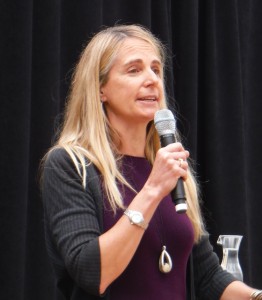 When you think of some of the world’s great brands, Virgin is often towards the top of the list. Richard Branson is passionate about making the world a better place. And as a result, he created Virgin Unite, and moved the head of his Australian mobile business to lead it. Jean Oelwang is the CEO of Virgin Unite. She partners to create new approaches to social and environmental issues, such as the Branson Centres of Entrepreneurship and a global platform to support budding entrepreneurs. Jean talked about business as a force for good. Business can and must be a force for good in the world. New approaches to leadership, supporting entrepreneurs to launch and grow businesses and helping businesses to prioritize people and planet along with profit. Uniting great people and entrepreneurial ideas, reinventing how we live and work is not only good for society, but for the bottom line.
When you think of some of the world’s great brands, Virgin is often towards the top of the list. Richard Branson is passionate about making the world a better place. And as a result, he created Virgin Unite, and moved the head of his Australian mobile business to lead it. Jean Oelwang is the CEO of Virgin Unite. She partners to create new approaches to social and environmental issues, such as the Branson Centres of Entrepreneurship and a global platform to support budding entrepreneurs. Jean talked about business as a force for good. Business can and must be a force for good in the world. New approaches to leadership, supporting entrepreneurs to launch and grow businesses and helping businesses to prioritize people and planet along with profit. Uniting great people and entrepreneurial ideas, reinventing how we live and work is not only good for society, but for the bottom line.
Each of the three Philanthropy Councils of The Conference Board presented a panel on a topic discussed at one of their recent meetings. Contributions Council I presented Improving Student Achievement Through the Use of Technology. Creativity as a Tool to Solving Social Issues was discussed by Contributions Council II. A recap of the Global Social Investing Council’s meeting in Beijing covered the opportunities and challenges of corporate giving in China. A blog on that meeting can be found at: http://jeffhoffmanassociates.com/Blog/?p=479
A dynamic trio from Gap, Inc., CECP and Cities of Service presented Volunteers: A Strategic Resource. A lively discussion ensued regarding how often corporate volunteers paint gyms, plant gardens, or clean up beaches, when they could be designing websites, drafting HR handbooks, or creating billing systems. For volunteers to tackle these types of projects, corporations and nonprofits need to think differently about how they collaborate, the role that volunteers can play, and driving impact. Reimaging Service’s final report was referenced as an important tool. http://jeffhoffmanassociates.com/Blog/?p=537
JPMorgan Chase, Investing in Detroit’s Future, was the first Impact Moment. $100 million investment in the next five years. This will be done through Community Development, Tackling Blight, Strengthening Workforce Readiness, Growing Small Businesses, Seeding Future Economic Growth and Skills-Based Volunteering. This is an incredible place-based program utilizing various elements of the company’s competencies and resources partnering with other companies, nonprofits and government. Collaboration at its best.
We all face the challenge of getting the word out. You have an amazing program. The impact is significant. But no one knows about it. This is not an uncommon problem. Seth Marbin of Google and Lauren Mihajlov of United Health Foundation discussed how to get your message through the clutter. Social media provides an incredible opportunity to reach people, so does traditional media. You aren’t just competing with external forces, positioning your message internally is critical.
 To close at the first day, Tim McClimon, President of the American Express Foundation shared Global Trends Impacting CSR in 2015. As the world becomes more complex, so do the jobs of CSR professionals. Navigating emerging issues is both critical and challenging. There are several trends that need to be on your radar. Tim’s blog outlines the trends: http://about.americanexpress.com/csr/csrnow/csrn155.aspx
To close at the first day, Tim McClimon, President of the American Express Foundation shared Global Trends Impacting CSR in 2015. As the world becomes more complex, so do the jobs of CSR professionals. Navigating emerging issues is both critical and challenging. There are several trends that need to be on your radar. Tim’s blog outlines the trends: http://about.americanexpress.com/csr/csrnow/csrn155.aspx
Day two began with all important data. Data that we need to prove the business case for what we do and demonstrate the impact that we make. Two recent studies were shared. Framing Social Impact Measurement (Conference Board Key Business Issue) and Giving in Numbers. http://www.conference-board.org/publications/publicationdetail.cfm?publicationid=2861 http://cecp.co/research/benchmarking-reports/giving-in-numbers.html
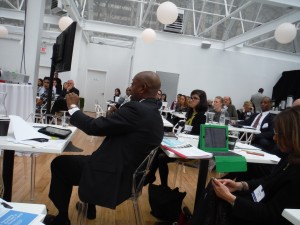 Three Impact Moments were presented. Financial Opportunity Corps a new program to help low and moderate income households achieve financial stability. The program helps clients develop strategies to reduce debt, improve credit to receive lower interest loans, start saving for emergencies and build assets through one-on-one or small group interaction with volunteers. This is an initiative of Bank of America working with Points of Light and AmeriCorps. The Environment. In enhancing our environment, we are improving the well-being of our communities.The Solar Habitat Program is a model for building visible, community programs that have a social, environmental, economic as well as a business benefits. This program has a focus on measurement, which is used to evaluate and evolve the approach taken to be more effective. Solar Habitat is a program of Pacific Gas and Electric Company. Digital Opportunity. Interconnectedness is bringing the world together. Still, there are many underserved communities that are either not connected to the internet, or have not yet realized the Web’s full potential. Equinix, Inc. is working with global NGOs through the Digital Opportunity framework.
Three Impact Moments were presented. Financial Opportunity Corps a new program to help low and moderate income households achieve financial stability. The program helps clients develop strategies to reduce debt, improve credit to receive lower interest loans, start saving for emergencies and build assets through one-on-one or small group interaction with volunteers. This is an initiative of Bank of America working with Points of Light and AmeriCorps. The Environment. In enhancing our environment, we are improving the well-being of our communities.The Solar Habitat Program is a model for building visible, community programs that have a social, environmental, economic as well as a business benefits. This program has a focus on measurement, which is used to evaluate and evolve the approach taken to be more effective. Solar Habitat is a program of Pacific Gas and Electric Company. Digital Opportunity. Interconnectedness is bringing the world together. Still, there are many underserved communities that are either not connected to the internet, or have not yet realized the Web’s full potential. Equinix, Inc. is working with global NGOs through the Digital Opportunity framework.
 Social Entrepreneurs: The New Frontier. B-Corps, Social Enterprises, Sustainable Business Practices, Shared Value. Strategic Philanthropy is now sharing space with other core elements of the business plan in tackling social and environmental challenges. Four organization, Points of Light Civic Accelerator, The Case Foundation, Shore to Shore Advisory and Library For All, both for-profit and not discussed the opportunities to create positive change through entrepreneurism.
Social Entrepreneurs: The New Frontier. B-Corps, Social Enterprises, Sustainable Business Practices, Shared Value. Strategic Philanthropy is now sharing space with other core elements of the business plan in tackling social and environmental challenges. Four organization, Points of Light Civic Accelerator, The Case Foundation, Shore to Shore Advisory and Library For All, both for-profit and not discussed the opportunities to create positive change through entrepreneurism.
Collective Impact is so much more than a current buzzword. Large-scale social change requires broad cross-sector coordination, yet the social sector remains focused on the isolated intervention of individual organizations. Substantially greater progress could be made in alleviating many of our most serious and complex social problems if nonprofits, governments, businesses, and the public were brought together around a common agenda to create collective impact. Laura S. L. Herman, Managing Director of FSG took the group through the Collective Impact framework and discussed the importance of funding a backbone organization to ensure that all of the parts are working properly.
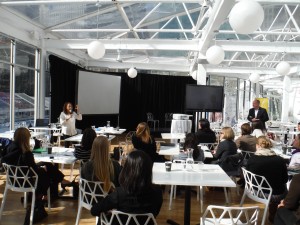 The grand finale of the symposium was presented by the grand dame of Purpose, Carol Cone of Edelman. Around the world, corporate leaders are stepping up to the “bully pulpit” making declarations, aligning organizational goals with select societal and environmental issues. These actions signify a shift in leadership, where societal issues are becoming integrated into core business strategy and culture. Organizational purpose, social innovation, reputation management, and stakeholder engagement are all at play. Proving the case for integration, and exceptional examples of focused campaigns with deep internal and external resonance was explored.
The grand finale of the symposium was presented by the grand dame of Purpose, Carol Cone of Edelman. Around the world, corporate leaders are stepping up to the “bully pulpit” making declarations, aligning organizational goals with select societal and environmental issues. These actions signify a shift in leadership, where societal issues are becoming integrated into core business strategy and culture. Organizational purpose, social innovation, reputation management, and stakeholder engagement are all at play. Proving the case for integration, and exceptional examples of focused campaigns with deep internal and external resonance was explored.
Participants of the Business-Community Impact Symposium left with their tool boxes full plus feeling energized and inspired.
